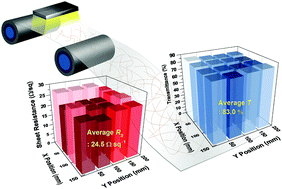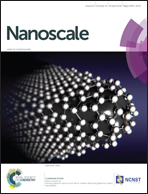Roll-to-roll-compatible, flexible, transparent electrodes based on self-nanoembedded Cu nanowires using intense pulsed light irradiation†
Abstract
Copper nanowire (Cu NW)-based flexible transparent conductive electrodes (FTCEs) have been investigated in detail for use in various applications such as flexible touch screens, organic photovoltaics and organic light-emitting diodes. In this study, hexadecylamine (HDA) adsorbed onto the surface of NWs is changed into polyvinylpyrrolidone (PVP) via a ligand exchange process; the high-molecular-weight PVP enables high dispersion stability. Intense pulsed light (IPL) irradiation is used to remove organic species present on the surface of the NWs and to form direct connections between the NWs rapidly without any atmospheric control. NWs are self-nanoembedded into a plastic substrate after IPL irradiation, which results in a smooth surface, strong NW/substrate adhesion, excellent mechanical flexibility and enhanced oxidation stability. Moreover, Cu NW FTCEs with high uniformities are successfully fabricated on a large area (150 mm × 200 mm) via successive IPL irradiation that is synchronized with the motion of the sample stage. This study demonstrates the possibility of roll-to-roll-based, large-scale production of low-cost, high-performance Cu NW-based FTCEs.


 Please wait while we load your content...
Please wait while we load your content...